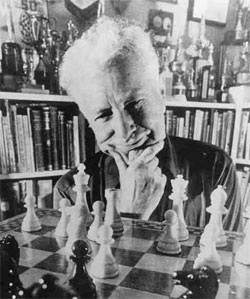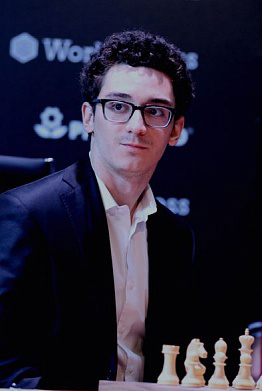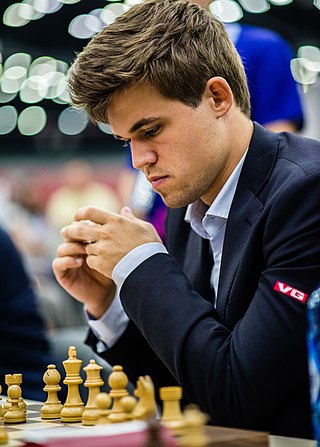Calculation of rating
Every competitive game played under the ECF system gives a "performance grade" that is "score" or "points" for each player (later used as the basis for an averaged cyclical or yearly grade, their "personal grade" they take into all matches in that cycle or year):

Thus if Player A who is graded 160 beats Player B graded 140, then, Player A's score for noting for later annual or cyclical averaging is 190; Player B's is 110. A whole series of 30 games drawing against a player results in a swap of personal grades. ECF grades appear to be zero-sum when looking at a game in isolation; however, negative scores are deemed zero. This means a player's grade after every six months is only then calculated.
The more games played, the more the end-of-cycle re-grading is affected directly or indirectly by this tiny inflationary effect at the bottom of the league so ECF grades are nonzero-sum. Countering this, a retiring or deceased master who had not appreciably shed points loses their accumulation available, otherwise open to competitors. The Federation has to recalibrate grades based on this discrete variable, and looks at the very approximate other-systems conversion formulae in so doing.
The unless part describes a tempering of the grade for future totting up as to disparate matches: players of grades facing each other of more than 40 points apart are deemed be exactly 40 points different. Had Player B's grade been 100, Player A would have scored: 170, and Player B: 90. This prevents players increasing their grade by losing to much higher-graded players and also means that the stronger player notes 10 points higher for their annual points tally (grade) when winning.
At the end of a cycle, each player's performance grades for that cycle are averaged to give the personal grade used for the following period. If fewer than 30 games have been played, games from last cycle(s) are usually included in the average to make the number up to 30.
A weakness of many other systems is treatment of juniors. Juniors tend to improve and therefore their rating/grading lags their current strength. The ECF grading system addresses this by changing the mathematical frame of reference for those aged under 18. The system above uses each player's grade from the previous cycle to calculate the personal grade. For juniors this uses year instead of cycle (including the recalculation of grades of junior opponents). It is this recalculation that becomes the performance grade for the final calculation for all players.
In theory a non-chess player would have a personal grade of 0; in practice negative grades exist but are set to 0 on the grading list. The weakest adult club players come in at about 40. A three-figure grade is a source of prestige among casual players, while those who seriously study the game may try to achieve a personal grade of 150. A player graded over 200 is usually well-known to rival circuits and might consider aiming for a master title. Grades far above 200 lose much of their significance as very strong players tend to play mostly in internationally rated tournaments.
The 150 Attack, a no-nonsense response to the Pirc Defence popularised by British players, derives from this system. Per Sam Collins in Understanding the Chess Openings this is because "even a 150-rated player could handle the White side".
Due to the inherent simplicity, a benefits it has over the Elo rating system used by FIDE, is scores are simple after each result without coded software or a calculator, and retention of personal grades over a cycle of typically at least 30 games.
Before 2005 all personal grades were confirmed by the former British Chess Federation: BCF grades.
Conversion to and from Elo ratings
Although the ECF grading system is mechanically very different from the Elo rating system, the ECF publishes formulae that can be used to estimate the equivalent ECF grade of a FIDE Elo rating, and vice versa: [2]


In the formula above E is the ECF rating (not Elo) and F is the FIDE rating.
The ECF grading system was recalibrated in 2009. Various other conversion formulae have been used, but usually relate to the forerunner.
This grades some games outside Federation matches where opponents lack an ECF grade. It is designed to give a best estimate conversion. It is often used by organisers of English congresses to determine qualification for grade-restricted events when a player has an Elo rating only.

Anatoly Yevgenyevich Karpov is a Russian and former Soviet chess grandmaster, former World Chess Champion, and politician. He was the 12th World Chess Champion from 1975 to 1985, a three-time FIDE World Champion, twice World Chess champion as a member of the USSR team, and a six-time winner of Chess Olympiads as a member of the USSR team. The International Association of Chess Press awarded him nine Chess Oscars.
Grandmaster (GM) is a title awarded to chess players by the world chess organization FIDE. Apart from World Champion, Grandmaster is the highest title a chess player can attain. Once achieved, the title is held for life, though exceptionally the title has been revoked for cheating.

The Elo rating system is a method for calculating the relative skill levels of players in zero-sum games such as chess. It is named after its creator Arpad Elo, a Hungarian-American physics professor.
The game of chess, or rather its immediate precursor, known as shatranj, was introduced to Europe from the Islamic sphere, most likely via Iberia, in the 9th or 10th century.

There are various systems of Go ranks and ratings that measure the skill in the traditional board game Go. Traditionally, Go rankings have been measured using a system of dan and kyu ranks. Especially in amateur play, these ranks facilitate the handicapping system, with a difference of one rank roughly corresponding to one free move at the beginning of the game. This system is also commonly used in many East Asian martial arts, where it often corresponds with a belt color. With the ready availability of calculators and computers, rating systems have been introduced. In such systems, a rating is rigorously calculated on the basis of game results.
Mark Callano Paragua is a Filipino chess grandmaster. He won the Philippine Chess Championship in 2012. He was the youngest Filipino master ever, at nine years of age. He also became the youngest Filipino GM ever at 20, beating Eugenio Torre's record by about two years.
The Chess Federation of Canada or CFC is Canada's national chess organization. Canadian Chess Association, founded in 1872, was replaced in 1932 by the Canadian Chess Federation (CCF), which for the first time included representation from all major cities in Canada. In 1945 the name was changed to avoid confusion with the Co-operative Commonwealth Federation. The CFC organizes tournaments and publishes national ratings. The highest rated player in Canada is Evgeny Bareev of Toronto.
Several methods have been suggested for comparing the greatest chess players in history. There is agreement on a statistical system to rate the strengths of current players, called the Elo system, but disagreement about methods used to compare players from different generations who never competed against each other.
Kenneth Harkness was a chess organizer. He is the creator of the Harkness rating system.

Arpad Emmerich Elo was a Hungarian-American physics professor who created the Elo rating system for two-player games such as chess.

Fabiano Luigi Caruana is an Italian and American chess grandmaster. A chess prodigy, Caruana became a grandmaster at the age of 14 years, 11 months, and 20 days—the youngest grandmaster in the history of both Italy and the United States at the time.
Swiss system tournaments, a type of group tournament common in chess and other board games, use various criteria to break ties between players who have the same total number of points after the last round. This is needed when prizes are indivisible, such as titles, trophies, or qualification for another tournament. Otherwise players often share the tied spots, with cash prizes being divided equally among the tied players.

A chess title is a title regulated by a chess governing body and bestowed upon players based on their performance and rank. Such titles are usually granted for life. The international chess governing body FIDE grants several titles, the most prestigious of which is Grandmaster; many national chess federations also grant titles such as "National Master". More broadly, the term "master" can refer to any highly skilled chess player.

A chess tournament is a series of chess games played competitively to determine a winning individual or team. Since the first international chess tournament in London, 1851, chess tournaments have become the standard form of chess competition among serious players.
Jeff Sonas is a statistical chess analyst who invented the Chessmetrics system for rating chess players, which is intended as an improvement on the Elo rating system. He is the founder and proprietor of the Chessmetrics.com website, which gives Sonas' calculations of the ratings of current players and historical ratings going back as far as January 1843. Sonas has written dozens of articles since 1999 for ChessBase.com and other chess websites. He was a participant in the FIDE ratings committee meeting in Athens, Greece in June 2010.
A chess rating system is a system used in chess to estimate the strength of a player, based on their performance versus other players. They are used by organizations such as FIDE, the US Chess Federation, International Correspondence Chess Federation, and the English Chess Federation. Most of the systems are used to recalculate ratings after a tournament or match but some are used to recalculate ratings after individual games. Popular online chess sites such as chess.com, Lichess, and Internet Chess Club also implement rating systems. In almost all systems, a higher number indicates a stronger player. In general, players' ratings go up if they perform better than expected and down if they perform worse than expected. The magnitude of the change depends on the rating of their opponents. The Elo rating system is currently the most widely used.
The Deutsche Wertungszahl is a chess rating system used in Germany. A higher rating number corresponds to a stronger player. A beginner is rated around 500 and a world champion about 2800.

FIDE titles are awarded by the international chess governing body FIDE for outstanding performance. The highest such title is Grandmaster (GM). Titles generally require a combination of Elo rating and norms. Once awarded, titles are held for life except in cases of fraud or cheating. Open titles may be earned by all players, while women's titles are restricted to female players. Many strong female players hold both open and women's titles. FIDE also awards titles for arbiters, organizers and trainers. Titles for correspondence chess, chess problem composition and chess problem solving are no longer administered by FIDE.
Performance rating in chess is the level a player performed at in a tournament or match based on the number of games played, their total score in those games, and the Elo ratings of their opponents. It is the Elo rating a player would have if their performance resulted in no net rating change. Due to the difficulty of computing performance rating in this manner, however, the linear method and FIDE method for calculating performance rating are in much more widespread use. With these simpler methods, only the average rating factors into the calculation instead of the rating of each individual opponent. Regardless of the method, only the total score is used to determine performance rating instead of individual game results. FIDE performance ratings are also used to determine if a player has achieved a norm for FIDE titles such as Grandmaster (GM).
The World Football Elo Ratings are a ranking system for men's national association football teams that is published by the website eloratings.net. It is based on the Elo rating system but includes modifications to take various football-specific variables into account, like the margin of victory, importance of a match, and home field advantage. Other implementations of the Elo rating system are possible and there is no single nor any official Elo ranking for football teams.









